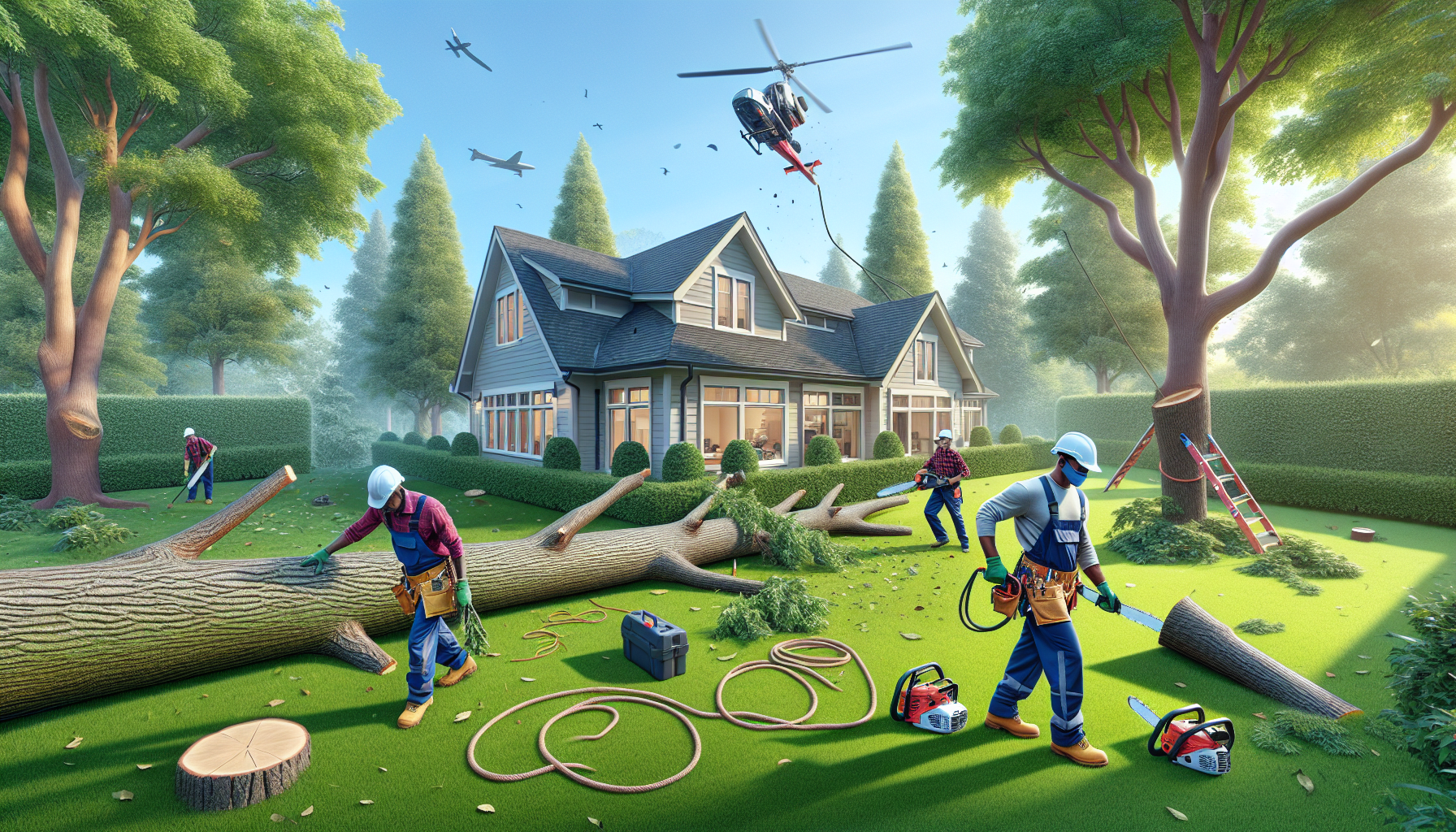
Unforeseen tree-related dangers can create immediate threats, making it essential to respond quickly for the sake of safety. When facing perilous situations, urgent tree services become vital to prevent potential harm and property damage.
Unlike routine care, these efforts are focused on addressing conditions that pose imminent risks, particularly after severe weather conditions.
Identifying the signs that indicate a need for hazardous tree removal, such as leaning trunks or exposed roots, is crucial for timely action.
Engaging professionals for tree assessment not only reduces risks but also ensures a safer environment during storm damage cleanup efforts.
Understanding Urgent Tree Services
Recognizing risks associated with trees is essential for ensuring safety. Addressing problems such as storm damage and tree disease as soon as possible can greatly enhance tree health and security. Regular tree trimming and proper maintenance are vital for effective tree assessment, especially when conditions indicate immediate action is necessary.
Timely responses are crucial for risk evaluation; warning signs like dead branches, leaning trunks, and exposed roots often indicate a pressing need for hazardous tree removal. Engaging certified arborists who apply proven techniques guarantees thorough inspections and tailored recommendations to manage risks effectively.
In emergencies, a prompt response not only protects your property but also lowers the chances of personal injury. Relying on experienced professionals equipped with the right service equipment and safety protocols leads to successful outcomes. Prioritize hiring skilled providers for rapid response tree services to ensure tree safety and preserve your landscape’s integrity.

What Is Hazardous Tree Removal
Addressing the risks highlighted earlier is crucial, especially when trees become hazards due to decay or disease. High winds can worsen these dangers, leading to structural instability in at-risk trees.
Identifying these dangerous specimens often requires the expertise of certified arborists, who are trained to perform thorough evaluations of potential hazards in your landscape. Their skill in tree assessment is vital for effective risk evaluation, ensuring prompt identification of issues.
The process of hazardous tree removal demands careful planning, emphasizing safety protocols to manage debris removal efficiently. Implementing proper techniques is essential for minimizing risks during the execution of tree felling, ensuring that safety measures are in place throughout the operation.
Once a tree has been removed, property owners should focus on landscape restoration and implementing long-term tree safety practices to protect the health of the remaining trees. This includes disease management, regular maintenance, and replanting efforts to promote a strong ecosystem.
How Storm Damage Cleanup Works
After discussing hazardous tree removal and the need for proactive tree assessment, it’s clear that prompt cleanup after severe weather events is a crucial next step. Acting quickly not only restores safety but also reduces the chance of greater property damage and environmental impact.
The first step involves a detailed safety evaluation to find hazards like fallen trees and hazardous debris that could threaten property and individuals. Professionals trained in storm damage cleanup are ready to provide expert tree health inspections, making sure that any damaged vegetation is properly assessed and dealt with.
Moreover, certified arborists who specialize in root removal are important when handling unstable trees that may present ongoing dangers. After the cleanup, a thorough post-assessment is vital for identifying any remaining risks, helping with immediate hazard identification and planning for future storms.
Following these important steps not only improves the safety of your area but also protects your investment in the landscape. By adopting effective tree care practices, such as tree trimming and disease management, property owners can boost their defenses against the effects of high winds and severe weather.
Additionally, landscape restoration and replanting efforts help to uphold ecosystem integrity while supporting long-term tree safety and health.
Importance of Tree Assessment
Building on the discussions about hazardous tree removal and storm damage cleanup, understanding the importance of regular tree assessment is essential for maintaining both safety and a thriving landscape. Keeping a close eye on tree health not only ensures their well-being but also reinforces the advantages they provide to the environment and surrounding ecosystems.
Understanding Tree Health starts with identifying signs of decline, such as wilting leaves or discoloration, which may indicate the need for timely vegetation management. Early identification allows for intervention against common diseases and pests that can weaken a tree’s structure, directly impacting their survival and effectiveness in property protection.
The Environmental Impact of well-maintained trees is significant, as they support local wildlife and improve air quality through photosynthesis. Healthy trees not only stabilize soil and prevent erosion but also aid land clearing efforts by promoting biodiversity. Furthermore, Safety Considerations cannot be overlooked, as identifying hazardous trees can prevent potential damage during maintenance, vegetation management, power line clearance, and landscape restoration.
Tree Health and Environmental Impact
- Regular tree evaluations can lead to early detection of diseases, enhancing tree longevity and reducing the need for emergency landscaping.
- Healthy trees can absorb up to 48 pounds of carbon dioxide per year, significantly improving air quality and contributing to overall environmental health.
- Maintained trees provide habitat for over 80% of terrestrial wildlife species, illustrating the critical role they play in preserving ecosystem integrity.
- Identifying hazardous trees can reduce risks associated with property damage and injury, shaping a safer environment for communities, especially during high winds.
Emergency Landscaping Best Practices
Importance of Quick Action
As we consider the vital role of tree assessment and the effects of storm damage cleanup, it is crucial to have effective strategies in place during landscaping emergencies. Quick, informed actions can significantly reduce the impact of unexpected challenges such as severe weather events or pest invasions.
Recognizing Immediate Threats
Common emergencies can lead to complications like soil erosion and unstable vegetation. Recognizing immediate threats is an essential first step in addressing these challenges. Look for indicators of danger, such as leaning trees or signs in soil analysis that suggest instability. Environmental factors, like heavy rainfall or drought, can worsen the health of your landscape, leading to increased risks.
Assessing Tree Stability
To ensure safety, conducting a thorough assessment of tree stability is necessary. Key signs include dead branches that may require branch cutting to prevent potential injuries. Furthermore, understanding the implications of tree health inspections can guide you in making informed decisions for better property protection.
Timely Intervention
When urgent actions are required, timely intervention becomes critical. Implementing safety protocols at the right moment protects individuals and enhances the effectiveness of tree trimming, maintenance, and preservation strategies, which are crucial in any situation. This preparedness ensures that emergency responders can act swiftly when needed.
How Does Tree Trimming Help
In light of the previous discussions surrounding tree assessment and emergency landscaping, ongoing tree care is vital for sustaining a healthy landscape. Maintaining a healthy environment for trees ensures their longevity and resilience, making regular maintenance through trimming an essential practice.
Removing dead or diseased branches not only protects trees from pests and diseases but also safeguards the broader ecosystem. By enhancing air circulation and increasing sunlight exposure, preventative measures like trimming contribute to stronger growth and improved tree health.
Identifying hazardous branches is crucial for maintaining safety, especially as they can pose significant risks during storms and high winds. Utilizing proper service equipment during maintenance minimizes potential hazards, ensuring that every effort is made for tree preservation.
For trees that are large or complex, seeking consultation from certified arborists can yield optimal results, allowing for a thorough evaluation of tree health and effective maintenance practices.
Tree Maintenance
- Regular trimming helps prevent the spread of pests and diseases by removing affected branches.
- Improved air circulation and sunlight exposure from trimming contribute to healthier and more vigorous tree growth.
- Identifying and removing hazardous branches reduces the risk of injury or damage during severe weather conditions.
- Consulting with professional technicians for large or complex trees ensures safe and effective maintenance practices.
Quick Risk Evaluation Techniques
Building on the previous discussions about tree assessment and the importance of tree care, understanding potential dangers posed by trees is essential for maintaining our landscapes’ integrity. Identifying hazards not only protects property but also ensures the safety of individuals nearby.
Regular visual inspections are vital to uncovering signs of decay and disease that could affect a tree’s stability and overall health. These assessments should include a thorough examination of the trunk, branches, and root system, checking for abnormalities or weaknesses that could indicate a risk.
Utilizing various tools, such as mallets and probes, can enhance the accuracy of evaluating environmental impact factors like soil quality and moisture levels. This detailed analysis helps in recognizing how local weather conditions and nearby structures might influence tree health and stability.
When uncertainties arise, it is wise to seek professional guidance from certified arborists. Their expertise can provide valuable insights for effective tree risk assessment and rapid response actions that may prevent further issues. Incorporating preventative measures, such as cabling and proper maintenance, can significantly contribute to tree safety and health over time.
Role of Certified Arborists in Emergencies
Continuing from the previous discussion on tree safety and risk evaluation, understanding the vital role of certified arborists during emergencies enhances community resilience. Their specialized training allows them to accurately assess threats posed by trees that may compromise both landscape integrity and public safety.
Expert Tree Assessment
By following established regulations, these experts efficiently manage trees during critical situations, always aiming to reduce risks to individuals and property. Their ability to perform thorough tree assessments is key in identifying hazardous trees that need urgent tree services.
Safe Hazardous Tree Removal
Employing advanced chainsaw operation techniques, they perform safe hazardous tree removal, ensuring that dangerous limbs or entire trees are cut down without incident. Their skills help protect the community during high winds or emergencies when tree safety is critical.
Post-Disaster Recovery
In the aftermath of a disaster, their thorough health inspection of trees is essential for effective disaster recovery. This includes addressing tree care needs and guiding efforts for replanting and revitalizing local ecosystems. Such proactive strategies help communities emerge stronger and more resilient after crises.
Tree Management in Crises
- Qualified professionals assess tree threats to ensure public safety and landscape integrity.
- Effective tree management during emergencies reduces risks to individuals and property.
- Advanced chainsaw techniques are utilized for the safe removal of hazardous trees and limbs.
- Post-disaster assessments guide replanting efforts, aiding in ecosystem recovery and community resilience.
Finding a Reliable Tree Removal Service Near You Made Easy
Affordable tree care makes a difference